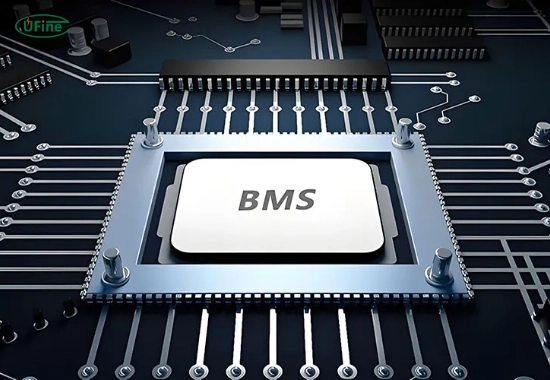A Battery Management System (BMS) is essential for batteries. It makes sure they work well and stay safe. The BMS watches over the battery, using different things to check, control, and keep the battery safe. This article discusses the BMS, explaining what it does and why it’s essential for maintaining healthy batteries and working great in different things.
Part 1. What does bms mean?(Battery management system)
Definition of Battery Management System
A Battery Management System (BMS) is a sophisticated electronic system designed to oversee and regulate rechargeable batteries’ charging, discharging, and overall performance. It encompasses an array of sensors, control algorithms, and communication interfaces that collaboratively ensure the optimal functioning and safety of the battery pack.
Components of a BMS
Sensors: These components within the BMS detect and measure critical parameters such as voltage, current, and temperature across individual battery cells. They provide real-time data crucial for the system’s decision-making processes.
- Microcontrollers (MCUs): Central to the BMS, MCUs process data from sensors, execute control algorithms, and manage the overall operation of the system. They make rapid, precise adjustments to maintain battery health.
- Communication Interfaces: Enabling interaction with external systems or users, communication interfaces (like CAN bus, UART, or SPI) facilitate data exchange, allowing for remote monitoring, diagnostics, and control.
- Safety Features: BMS includes safety mechanisms like overvoltage protection, undervoltage protection, and overcurrent protection. These features prevent hazardous conditions and safeguard the battery against potential failures.
Part 2. Functions and features of BMS
Voltage Monitoring
Voltage monitoring is a pivotal function within a Battery Management System (BMS), focusing on continuously surveilling individual battery cell voltages. This critical feature ensures that each cell operates within its safe voltage range, averting potential overcharging or deep discharging situations that could compromise battery health or safety.
- Continuous Cell-Level Monitoring: BMS employs dedicated voltage sensors connected to each battery cell. These sensors provide real-time voltage readings, allowing the system to track cell voltage variations accurately.
- Threshold Management: The BMS sets specific voltage thresholds, defining upper and lower limits within which each cell must operate. Should any cell exceed these limits, the BMS triggers corrective actions to mitigate potential risks, such as cell balancing or disconnection from the circuit.
- Balancing Control: In cases where discrepancies in cell voltages arise, the BMS initiates balancing processes to redistribute charge among cells. This action ensures uniformity in voltage levels across the battery pack, optimizing overall performance and extending battery life.
- Safety Precautions: Voltage monitoring is a preventive measure against hazardous conditions like overvoltage, which can lead to cell degradation, overheating, or even catastrophic failure. The BMS promptly detects irregularities and protects the battery and surrounding components from potential damage or safety hazards.
Current Monitoring
Current monitoring within a Battery Management System (BMS) serves as a critical function, meticulously tracking the current flow within the battery pack to prevent overcharging or deep discharging scenarios.
- Real-Time Current Measurement: BMS integrates current sensors that continuously measure the current entering or exiting the battery pack. This real-time monitoring allows the system to precisely gauge the charge transferred in or out of the cells.
- Overcharge Protection: By monitoring the incoming current during the charging process, the BMS ensures that the battery does not receive excessive charge beyond its capacity. If the current surpasses predefined thresholds, the BMS intervenes, regulating the charging process to prevent overcharging, which can degrade cell chemistry and compromise safety.
- Deep Discharge Prevention: Similarly, the BMS tracks the outgoing current during discharge. It initiates actions to prevent the battery from discharging beyond safe limits. This functionality safeguards against deep discharge, which can lead to irreversible damage and reduced battery lifespan.
- Balancing Actions: Current monitoring also aids in identifying imbalances among cells in a battery pack. Suppose disparities in current draw or charge are detected among cells. In that case, the BMS initiates balancing procedures, redistributing charge to maintain uniformity across the cells.
- Enhanced Battery Longevity: The BMS significantly extends the battery’s lifespan by effectively managing current flow. It prevents harmful charging or discharging conditions, preserving the cells’ health and overall performance.
Temperature Management
Temperature management is a fundamental feature within a Battery Management System (BMS), entailing a comprehensive strategy to monitor and regulate battery temperature for optimal performance and safety.
- Temperature Sensors: The BMS integrates precise temperature sensors strategically placed within the battery pack. These sensors continuously monitor the temperature of individual cells or sections of the battery, providing real-time data to the system.
- Thermal Regulation: With the collected temperature data, the BMS employs sophisticated algorithms to regulate the battery’s thermal conditions. It initiates actions such as adjusting charging rates, limiting discharging rates, or activating cooling systems to maintain the battery within its safe temperature range.
- Overheat Prevention: One of the primary roles of temperature monitoring is to prevent overheating, which can lead to accelerated degradation of battery cells and, in extreme cases, pose safety hazards. The BMS intervenes by implementing cooling measures or limiting charging/discharging activities if temperatures approach unsafe levels.
- Optimization of Performance: Effective temperature management ensures safety and optimizes the battery’s performance. The BMS enhances the battery’s efficiency and extends its operational lifespan by maintaining an ideal temperature range.
- Safety Precautions: Additionally, temperature monitoring is a preemptive safety measure against thermal runaway, a critical condition where a battery rapidly self-heats, potentially leading to catastrophic failure. The BMS promptly identifies and manages temperature spikes, averting such hazardous scenarios.
State of Charge (SOC) and State of Health (SOH) Estimation
Battery SOC :
- Algorithmic Calculations: BMS employs sophisticated algorithms that analyze parameters like voltage, current, temperature, and sometimes even historical usage data to estimate the State of Charge. These algorithms provide a reasonably accurate representation of the remaining charge in the battery.
- Accuracy Enhancement: Continuous refinement of SOC estimation algorithms enhances accuracy, allowing for precise determination of how much energy remains available enabling better management of charging and discharging cycles.
- Degradation Analysis: The BMS evaluates multiple factors, including cycling history, temperature profiles, and voltage trends, to estimate the State of Health. It assesses how much the battery’s capacity has reduced over time, providing insights into its overall health and longevity.
- Predictive Modeling: Utilizing data gathered during various battery states, the BMS creates predictive models to estimate how the battery’s capacity diminishes over its lifespan. This information aids in forecasting when maintenance or replacement might be necessary.
- Decision Support: SOC and SOH estimations serve as critical parameters for decision-making, guiding users or systems in determining optimal usage patterns, scheduling maintenance, or identifying potential battery issues before they become critical.
Balancing Function
The balancing function within a Battery Management System (BMS) is pivotal in maintaining voltage equilibrium among individual cells within the battery pack, preventing issues like cell drift and ensuring optimal performance.
Cell Voltage Equalization:
- Detection of Voltage Variations: The BMS continuously monitors and detects discrepancies in cell voltages. Variations can occur due to differences in cell capacities, aging, or external factors impacting specific cells.
- Initiation of Balancing: When significant voltage imbalances are identified, the BMS activates balancing circuits or components. These circuits redistribute charge among cells by shunting excess charge from higher voltage cells to lower ones or enabling the controlled discharge of overcharged cells.
- Passive Balancing: This involves dissipating excess energy through resistors or bypass circuits, effectively equalizing cell voltages by drawing current from cells with higher voltages.
- Active Balancing: Utilizes additional components, such as DC-DC converters, to transfer energy between cells actively. This technique can be more efficient but might involve more complex circuitry.
- Continuous Monitoring and Correction:
- Real-Time Adjustment: The BMS performs continuous monitoring and adjusts the balancing process as needed, ensuring cells remain within safe voltage ranges and minimizing the risk of cell degradation or failure.
- Safety Measures: Balancing functions optimize performance and serve as a safety measure. By preventing voltage drift and maintaining equilibrium, the BMS minimizes the likelihood of hazardous conditions like thermal runaway due to imbalanced cells.
Part 3. FAQs
-
How does a BMS impact battery lifespan?
A Battery Management System (BMS) helps monitor and regulate charging, discharging, and overall battery health, thereby extending the lifespan of batteries by preventing overcharging, over-discharging, and balancing cell voltages. -
What does a battery management system do?
A BMS controls various aspects of battery operation, including monitoring cell voltage, temperature, and current flow, balancing cell charges, and protecting against overcharging or over-discharging. -
Do all batteries have a BMS?
No, not all batteries have a BMS. While some batteries, particularly lithium-based ones used in sensitive applications, employ a BMS, others, like disposable alkaline batteries, typically do not include such management systems. -
How do you charge a lithium battery without a BMS?
Charging a lithium battery without a BMS requires careful monitoring of the charging process, ensuring the battery is not overcharged or over-discharged, and manually balancing cell voltages, which can be challenging and potentially risky. -
Which type of battery does not require a BMS?
Some non-rechargeable batteries, like primary alkaline or zinc-carbon batteries used in low-drain devices, typically do not require a BMS as they are not rechargeable and have different chemical compositions compared to rechargeable lithium-based batteries.
Related Tags:
More Articles

What You Need to Know About AA 3.6V Lithium Battery
Learn all about AA 3.6V lithium batteries—voltage, size, capacity, uses, and the best replacements. Discover why they’re powerful, and highly reliable.
What Are Lithium Salts and Why They Matter in Battery Electrolytes
Lithium salts in electrolytes are key to battery performance, powering everything from phones to EVs and shaping the future of clean energy.
Lithium AAA Battery Guide: Power, Performance & Chargers
Explore lithium AAA batteries—voltage, capacity, weight, top brands, and more. Learn how to choose the best battery for your device and why it really matters.
How to Calculate Watts, Volts, and Amps (With Simple Formulas and Examples)
Learn how to calculate watts, volts, and amps for lithium batteries with simple formulas and examples, ideal for EVs, solar, and energy systems.
Comprehensive Analysis of U.S. Tariffs on Chinese Lithium Batteries
U.S. tariffs on Chinese lithium batteries in 2025 impact costs, supply chains, and EV, energy storage, and electronics industries globally.





